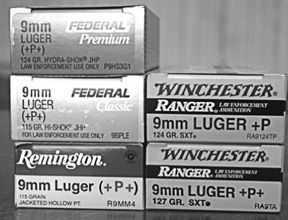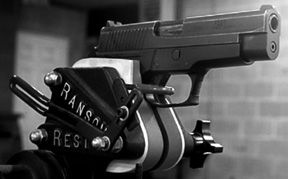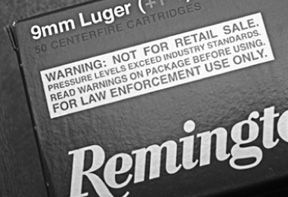
The 9mm Parabellum cartridge (commonly called 9mm Luger in the US) has traditionally been loaded more lightly on this side of the Atlantic than in Europe. The Sporting Arms and Ammunition Manufacturing Institute (SAAMI) has set a pressure ceiling for standard pressure 9mm Para at 35,000 pounds per square inch (psi). By contrast, NATO pressure ceiling is 42,000 psi. In-between U.S. standard pressure 9mm and NATO spec, we have two options. 9mm +P has a SAAMI pressure ceiling of 38,500 psi. There’s no SAAMI spec for 9mm +P+; that’s just a way of saying its pressures exceed +P standards.
The impetus to develop a higher-pressure — thus higher velocity — domestic 9mm load came from our nation’s police. By the mid/late-1980s many departments were trading in their .357 Magnum revolvers for 9mm auto pistols. However, they still wanted .357 Magnum stopping power. Thus was born the concept of the +P+ 9mm. Such loads typically increase velocity of a 9mm projectile from between 100 to 200 feet per second (fps). A 9mm auto stuffed with +P+ ammo is, in effect, a high-capacity, fast-firing, quick-reloading .357 Magnum. (A hot 9mm generates muzzle energies equivalent to a .357 Magnum 110-grain jacketed hollowpoint, a round most shooters take seriously.)
The 9mm’s popularity in police service has taken a hit in the last ten years or so. Once it was the most popular police cartridge in North America; today that title belongs to the .40 S&W. Among ordinary citizens, the 9mm’s popularity was adversely affected by the now-expired Assault Weapons Ban and its prohibition on importation or domestic manufacture of detachable box magazines holding more than 10 rounds. With 9mm and .40 magazines holding the same number of rounds, many shooters decided, “If I can only get 10-shot mags, I want them holding the fattest rounds possible.” Now that the ban’s expiration has restored the 9mm’s capacity advantage, we look for the fortunes of this cartridge to recover somewhat in the future.
As a general rule, 9mm +P ammunition is sold to both police and the general public, but +P+ 9mm is sold only to police agencies, which have to sign a waiver saying they won’t sue if anything goes wrong. The exception to this rule is Winchester, which restricts both its +P and +P+ 9mm to police-only sales.
In this article we tested five hot 9mm loads, because, though this ammunition is ostensibly “police-only,” it does tend to find its way onto the commercial market. For instance, while this article was being prepared, we received word a local commercial gun shop had just gotten in a big shipment of Winchester +P and +P+ 9mm.
Our test ammo included the Federal Classic 115-grain Hi-Shok JHP +P+, product code 9BPLE, basically the company’s famous 9BP load pumped up to +P+ pressures. Also from Federal was the Premium 124-grain Hydra-Shok JHP +P+ (No. P9HS3G1). From Remington we tested the 115-grain JHP +P+ (No. R9MM4). Winchester Ranger brands were the 124-grain SXT +P (No. RA9124TP) and 127-grain SXT +P+ (No. RA9TA).
Our test gun was an older, though lightly used, example of Sig’s P226 in 9mm, a cartridge/design combination with an excellent reputation and track record for reliability and accuracy. Barrel length on the P226 was 4.4 in. We acquired it from Bull’s-Eye Shooter Supply (414A Puyallup Ave, Tacoma, WA 98421, [253] 572-6417).
Our testing procedure had several stages in it. If a round was found wanting at any stage, it was removed from the rest of the test, and the survivors continued. The stages are described briefly below; a more detailed testing procedure can be viewed and downloaded free of charge at www.gun-tests.com/performance/ammunition.html.

Reliability. Every round fired passed the reliability portion of the test. The gun worked perfectly. What did you expect? This was a 9mm Sig P226.
Velocity.Every round tested passed the standard for consistent velocity, and several posted tight standard deviations (SDs). The Federal 124-grain Hydra-Shok +P+, Remington 115-grain JHP +P+, and Winchester 127-grain SXT +P+ posted single-digit SDs. For ammunition whose entire purpose is to offer more energy than standard-pressure 9mm, we wondered how more velocity these +P and +P+ rounds generated above standard-pressure ammo. Typical standard-pressure 9mm defense-load figures would show a 115-grain jacketed hollowpoint at 1150 fps generating 337.8 foot-pounds of muzzle energy (ME), or a 124-grain JHP at 1100 fps generating 333.2 foot-pounds ME. In this regard we’d have to flunk the Federal 124-grain Hydra-Shok +P+ at 357.3 foot-pounds and the Winchester 124-grain SXT +P at 364.9 foot-pounds. They simply don’t offer enough additional ME compared to standard-pressure 9mm to justify their choice over more easily available and cheaper loads. In ascending order of ME generated, the Winchester 127-grain SXT +P+ at 405.5 foot-pounds, Remington 115-grain JHP +P+ at 425.0 foot-pounds, and Federal 9BPLE at 427.7 foot-pounds were another story.
Thus, the Federal 9BPLE, Remington 115-grain JHP +P+, and Winchester 127-grain SXT +P+ rounds continued on to the next phase of testing.
Accuracy.The Federal 9BPLE failed to make the accuracy standard with a 2.2 in. average. This round shot quite high, about 4 inches at 50 feet with the Sig’s fixed sights. The Winchester 127-grain SXT +P+ gave a 1.8-inch average and was spot-on for elevation. The Remington 115-grain JHP +P+ met the standard with a 2.0-inch average, but it shot groups 3 inches high at 50 feet. Shooters choosing this load for self-defense should have guns fitted with adjustable sights to bring point of impact in line with point of aim. The Remington 115-grain JHP +P+ and Winchester 127-grain SXT +P+ continued on to the next phase of testing.
Recoil Level.Both rounds met our standard for controllable recoil. The Remington 115-grain JHP +P+ generated a 148.4 power factor (pf), and the Winchester 127-grain SXT +P+ had a 152.3 pf, both well under our 200 pf ceiling. That’s one very nice thing about 9mm +P+ ammunition: For the power these loads are putting out, recoil is not at all bad.
Penetration, Expansion and Weight Retention.Because of reader requests, we will be providing penetration, expansion, and weight-retention information for all rounds tested, not just those meeting our standards to this point. Therefore shooters who might have different preferences or priorities than Gun Tests staff members can make their own decisions. We’ll begin with the two rounds that, thus far, have satisfied all of our other requirements.
The Remington 115-grain JHP +P+ expanded to 0.52 inch and penetrated 15 inches. Recovered bullet weight was 84.6 grains. Obviously, this bullet had eroded considerably; multiple lead fragments were found in jug #2, and there were more fragments in #3 along with the expanded slug. There’s a theory such bullet break-up is a good thing, that a projectile that expands so violently its edges actually shear off in water or gelatin will always expand in flesh.
The Winchester 127-grain SXT +P+ expanded to 0.69 inch and penetrated 15 inches. Recovered weight was 119.5 grains. The SXT bullet design obviously did its job well by generating great expansion and weight retention.

Moving on to the other three rounds, the Federal 124-grain Hydra-Shok JHP +P+ expanded to 0.70 inch and penetrated 12 inches. Recovered weight was 111.2 grains. The Winchester 124-grain SXT +P likewise expanded to 0.70 inch; it penetrated 15 inches, and its recovered weight was 117.8 grains. The Federal 115-grain JHP +P+ 9BPLE penetrated 15 inches, shedding its jacket and coming apart in the process. There were two small pieces of lead in jug #2, likewise two pieces of jacket material. Moving into jug #3, we found two more small pieces of lead, the remainder of the jacket, and the severely eroded main portion of the bullet, 0.43 inches wide by 0.24 inches tall, weighing 51.4 grains. Taking every fragment that made it into jug #3 and weighing them together showed a weight of 84.7 grains.
Gun Tests Recommends
• Federal Classic 115-grain Hi-Shok JHP +P+ No. 9BPLE; Federal Premium 124-grain Hydra-Shok JHP +P+ No. P9HS3G1; Winchester Ranger 124-grain SXT +P No. RA9124TP. Don’t Buy. The Federal 124-grain Hydra-Shok +P+ and the Winchester 124-grain SXT +P don’t offer enough additional muzzle energy compared to standard-pressure 9mms to justify buying them. The Federal 115-grain JHP +P+ didn’t meet our accuracy standard.
• Remington 115-grain JHP +P+ No. R9MM4. Buy It. This load was within a few fps of posting the highest muzzle energy of any round tested. Its accuracy was acceptable, though not wonderful. It expanded violently and penetrated reasonably. If you choose this load, your gun should have adjustable sights, otherwise it might hit high.
• Winchester Ranger 127-grain SXT +P+ No. RA9TA. Our Pick. While not the hottest ammo tested, this load still generated more than 400 foot-pounds of energy and was the most consistent ammunition velocity-wise at a mere 7 fps SD. Accuracy was decent. It expanded well, had great weight retention, and penetrated within acceptable limits. Either of these loads would make a superior choice for self-defense, though we lean toward the Winchester 127-grain SXT +P+ by virtue of its accuracy, consistent velocities, and that it hit point of aim with a fixed-sight gun set up for standard-pressure ammo.
Also With This Article
[PDFCAP(1)]


























muzzle energy, or correctly called kinetic energy, is only half of the equation for penetration. you need power factor to push it through. that’s why heavier bullets like 147 grain penetrate just as much even though they have less KE.
what these light and fast 115 and 124 grain Wonder Bullets are doing, is dumping energy rapidly from the start, tearing up tissue, and that’s supposed to be their claim to fame. they still penetrate as much because of the high KE, and that is despite the low PF. that is why you see them fragment, which is a bad thing. penetration of those little pieces is too shallow.
comparing them to a .357 Magnum, they don’t have 500+ ft-lbs of KE and they don’t have 185 lb-ft of PF so they will neither tear up tissue nor extend that cone of torn up tissue into the target like a .357 does.
yes these loads push 9mm as far as it can go in terms of light and fast, but they are no .357 Magnum, the heavier and slower loads are just as worthy, the 115 grain Federal should have continued because Kentucky windage with fixed sights is the nature of the beast with handguns, and if someone want a more powerful 9mm that bad they should think about getting a .40 instead. all of the above explains why.
REQUEST FOR QUOTE
CARTRIDGE, AMMUNITION:GUN;BRASS;9MM/P
82 each
CARTRIDGE, AMMUNITION: TYPE: GUN; MATERIAL: BRASS; QUANTITY: 50 PER
BOX; WEIGHT: 0.63KG PER BOX; CALIBER: 9MM/P; SUPPLY NEW NOT RELOADED
AMMUNITION
Super super hot 9mm ammunition can have some overlap, in terms of power level, with the low end of .357 Magnum. I believe you can get hot 9mm ammo with a 115gr bullet at 1300 or so, and a .357 Mag load with a 110gr JHP at 1300 or so was the Border Patrol’s duty load once upon a time, and I never met a Border Patrol officer back then who had anything bad to say about its performance in the antipersonnel role.
But I do not think anybody’s pushing 158-grain jacketed bullets out of a Glock 19 at 1300 feet per second. The 9mm cartridge just isn’t capable of it, but that’s the power level of .357 that hasn’t been watered down.
There is “Major Nine” 9mm handload data out there that people use for IPSC competition, which tends to run at 55K+ PSI and requires a pistol with an extra heavy recoil spring and a barrel with lots of freebore so that long truncated-cone bullets like the Hornady 115gr HAP match bullet will chamber without resistance when loaded out to 1.150″. The pressures require it to be loaded with small rifle magnum primers to prevent the primers from getting pierced at the firing pin indentation. These loads will push 1600 ft/sec out of a Glock 34. The high pressures are a feature, not a bug, for this application because they make the muzzle brake screwed to the end of the barrel work a little better. Even at those pressures, though, you’re not going to get very impressive performance with bullets lighter than around 125 grains. The case capacity just isn’t there. This isn’t a comparison we can really make.
I like the 9mm+p offerings for self defense. Fast forward a couple of decades from this article and we have much better 9mm offerings in the 2020’s than we did at the turn of the century. The Federal 124 grain HST round in a 9mm+p loading is an excellent choice. Buffalo Bore and Underwood +P and +P+ loadings are both good penetrators and man stoppers without resorting to using a magnum revolver. The striker fired high capacity 9mm pistols have come a long way from the da/sa and dao hammer fired guns that dominated the market in the late 80’s through the turn of the century and even though 9mm isn’t a .357 or a .40, one has to admit that the 9mm+p in a modern handgun with the bonded hollow point projectiles that are available today does a pretty good job for personal protection and law enforcement usage.
Mostly agree, except the comment on the actual action of the pistols in popularity these days. DA/SA, and SAO, are just as popular if not more so than the 80’s and 90’s. Beretta 92’s/96’s, CZ’s, and 2011’s are everywhere, and dealer’s can’t keep them in stock. Even the “oldies” like P226/P229/P220 still sell. I just bought a CZ P07 DA/SA, after only owning striker fired pistols for years (Springfield XDM Compact .40 S&W, and a Walther PDP Pro SD Compact 9mm), and it’s my current favorite. I actually WISH it wasn’t as popular, because I can’t get the parts I want for it, as they’re constantly sold out or on backorder. Same for any custom work, all the shop lead times are crazy right now. It’s not so much pistol popularity, it was the research and increased bullet performance that brought back the 9mm in popularity. Now you don’t “have to” step up to a .40SW or .45ACP for great self defense performance, and could make do with a compact 9mm with higher mag capacity. The action of the pistols had less to do with that than bullet performance gains.
Sellier + Bellot 115 grain 9mm standard range ammo has 418 ft/lb energy (1280 ft/s velocity) – this is the highest non +p rated ammo I have seen. I have a ton of boxes of it and buy it anytime I see it available in stores.
This article was written in 2005. LOTS have changed in the last 19 years. .40 is DOA and the 9mm rules the civilian and LE sales. All started with the FBI going back to the 9mm. Ammo prices are MUCH higher now too. Lots of newer models since 2005 including Glock Gen 4 & 5, HK VP9, Sig 320 series being adopted as the M17 & M18, S&W M&P 2.0, Walther PPQ & now the PDP. Micro Optic ready guns are now the norm. Tiny pocket double stack 9mm are in vogue too like the Hellcat, P365 & Shield plus with nearly ALL states having some form of licensed concealed carry for civilians. Great time to buy a new 9mm!